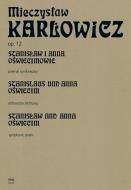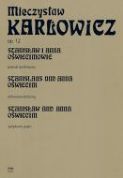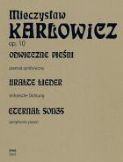Stanislaw and Anna Oswiecim Op. 12 (Symphonic Poem) - orchestra (full score)
Stanislaw and Anna Oswiecim Op. 12 (Symphonic Poem) - orchestra (full score)
* Estimated price converted from UK retail price
The genesis of the symphonic poem Stanislaw and Anna Oswiecim [Stanislaw i Anna Oswiecimowie] reaches deep into the composer’s youth and is shrouded in mystery. Adolf Chybinski, the composer’s scrupulous biographer, notes that between 9 and 14 February 1893 the Karlowiczes and their children were in Cracow for the wedding of their daughter Wanda and Zygmunt Wasilewski, when the then sixteen-year-old Mieczyslaw saw Stanislaw Bergman’s painting Stanislaw Oswiecim beside the Body of Anna Oswiecim [Stanislaw Oswiecim przy zwlokach Anny Oswiecimówny] on display in the Cloth Hall. Bergman, a talented pupil of Jan Matejko, was born in Krosno, where since the seventeenth century the burial crypt of the Oswiecim siblings had stood in the Baroque chapel-mausoleum in the Franciscan church. The subject of a local cult, around the turn of the nineteenth century that crypt became the source of a popular, and thoroughly Romantic, legend of the tragic love between brother and sister. The legend fell on fertile soil in the young Mieczyslaw’s psyche. As we know from several people close to the composer – Helena Romer-Ochenkowska, Alina Swiderska and Kazimierz Prószynski – Mieczyslaw was extremely fond of his cousin Ludwika Sniadecka; a close acquaintance of the composer, Stanislaw Szumowski, suggested that this youthful love played a crucial role in the later inspiration of the symphonic poem. The Romantic motif of unrequited love, or of an unhappy or tragic love, appeared already in Karlowicz’s songs, then in his overture to The White Dove [Biala golabka] and his first symphonic poem, Returning Waves [Powracajace fale]. Karlowicz showed a particular liking for such stories. But was he merely following the fashion of his melancholy, pessimistic times? Certainly not. Such an attitude was undoubtedly fuelled by personal experience and by the composer’s mental disposition – his depressive nature and solitude. And so the poem Stanislaw and Anna Oswiecim is a characteristic example of the musical setting of the Romantic myth of ‘unhappy love’; it is a programme work, in which the dramatic narrative is transformed into a finalistic structure of ‘an aspiration to eternity’.







